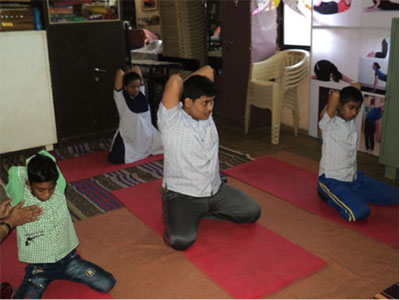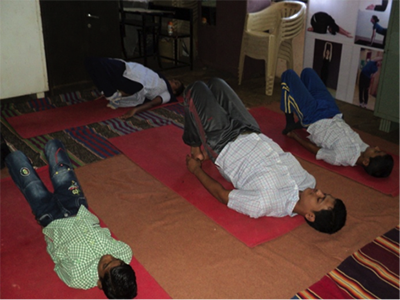Image may be NSFW.
Clik here to view.
Parenting is a hard enough task at the best of times, but few people have a more challenging time than the parents of children with mental disabilities. Their job is made all the more difficult by the fact that community resources for people with intellectual disabilities (whose population was estimated to more than fifteen lakhs as per the 2011 Indian Census data on disability) are severely limited. Caregivers often find themselves at a dead-end as they look for ways to improve their wards' quality of life. In such a scenario, yoga, a powerful, easily teachable, as well as inexpensive body-mind practice carries the potential to play an important role through the principle of neuroplasticity, the brain's inherent capacity to rewire itself. When personalised for intellectually disabled (ID) children according to their needs and capacities, yoga could become an important means for their self-development and rehabilitation, helping them and their family to live better, fuller and more meaningful lives.
"[E]ach of the four children [studied] showed a marked improvement in span of attention, sensory-motor coordination, gross and fine motor skills, overall stability of posture and ability to follow instructions correctly without much time-lapse."
In fact, a recent case study conducted by the Scientific Research Department (SRD), Kaivalyadhama Yoga Institute, with four mild-moderate ID children from a Lonavala-based non-profit special school, Samwad Shala, revealed that after five months of regular yoga training (five days per week for one hour daily), each of the four children showed a marked improvement in span of attention, sensory-motor coordination, gross and fine motor skills, overall stability of posture and ability to follow instructions correctly without much time-lapse. Video-recordings, psychological tests, as well as personal observations served as sources of data for the above results. Yoga training was conducted in two sustainably progressive modules in this exploratory research project. Delightfully, the results with these four ID children were so encouraging that Samwad Shala introduced regular yoga practice for one hour daily as a part of its school curriculum for all its 25 children. Some research studies carried out in the 1980s by yoga institutes in India had also demonstrated similar benefits of yoga on ID children, with the additional effect of improvement in IQ levels as well as social adaptation.
The improvements due to yoga mentioned above not only create possibilities for the ID children to better manage their daily lives but also for their caregivers to create avenues for their rehabilitation. Possibilities emerge due to the neuroplastic brain; when ID children follow the instructions of yogasanas regularly and repeatedly, it stimulates the firing of various types of sensory and motor neurons in their brain, that in turn result in the wiring and re-wiring of neural pathways. It is much like creating road-maps in the brain and traversing them often!
Image may be NSFW.
Clik here to view.
Let us, for example, take the case of kinesthetic sense (the sense of relative positions of various parts of the body), which is very important for motion, balance and orientation. As many yogasanas are done with the left and right side of the body separately as well as jointly in a slow, rhythmic and sequential manner with hold-time, ID children improve on their range of motion, develop greater awareness of each part of the body, its different movements, understand how those movements can be used to achieve balance in different ways, learn to sustain that sense of balance, and thereby, improve their kinesthetic sense. Here, it is a two-way traffic of neural signals, one from the brain to the movement-causing muscles, and the other from those muscles to the brain.
"[T]he improvements in the above study were not just physical and cognitive... there was greater emotional and behavioural self-regulation in the children."
Another example is procedural memory, a type of long-term muscle-memory that happens when complex activities, like riding bikes, are done over and over again, eventually making them effortless. When ID children repeatedly follow instructions for complex yoga practices such as Suryanamaskar, they improve their procedural memory and learning. Since it is difficult to teach complex and slightly risky activities like riding to ID children, yoga serves as a safe and effective option to stimulate two-way traffic between the brain and body. When more of this two-way traffic keeps happening in the brain through yoga, possibilities for bonus road-maps of other skills start to develop in the brain.
What is more, the improvements in the above study were not just physical and cognitive! The yoga teacher, the school in-charge, and the parents reported that there was greater emotional and behavioural self-regulation in the children. Their irritability reduced and their patience and sociability improved. The self-confidence of one child improved so much that she now takes the lead in demonstrating yogasanas during the school's daily yoga program.
Samwad Shala integrating yoga into its curriculum is a worthy milestone in the direction of holistic child education. This clearly indicates that participatory research in yoga can motivate, create and sustain social impact and be the means for change in the community. What a wonderful example of research outliving itself by turning into social empowerment!
Image may be NSFW.
Clik here to view.![]() Like Us On Facebook |
Like Us On Facebook |
Image may be NSFW.
Clik here to view.![]() Follow Us On Twitter |
Follow Us On Twitter |
Image may be NSFW.
Clik here to view.![]() Contact HuffPost India
Contact HuffPost India
Clik here to view.

Parenting is a hard enough task at the best of times, but few people have a more challenging time than the parents of children with mental disabilities. Their job is made all the more difficult by the fact that community resources for people with intellectual disabilities (whose population was estimated to more than fifteen lakhs as per the 2011 Indian Census data on disability) are severely limited. Caregivers often find themselves at a dead-end as they look for ways to improve their wards' quality of life. In such a scenario, yoga, a powerful, easily teachable, as well as inexpensive body-mind practice carries the potential to play an important role through the principle of neuroplasticity, the brain's inherent capacity to rewire itself. When personalised for intellectually disabled (ID) children according to their needs and capacities, yoga could become an important means for their self-development and rehabilitation, helping them and their family to live better, fuller and more meaningful lives.
"[E]ach of the four children [studied] showed a marked improvement in span of attention, sensory-motor coordination, gross and fine motor skills, overall stability of posture and ability to follow instructions correctly without much time-lapse."
In fact, a recent case study conducted by the Scientific Research Department (SRD), Kaivalyadhama Yoga Institute, with four mild-moderate ID children from a Lonavala-based non-profit special school, Samwad Shala, revealed that after five months of regular yoga training (five days per week for one hour daily), each of the four children showed a marked improvement in span of attention, sensory-motor coordination, gross and fine motor skills, overall stability of posture and ability to follow instructions correctly without much time-lapse. Video-recordings, psychological tests, as well as personal observations served as sources of data for the above results. Yoga training was conducted in two sustainably progressive modules in this exploratory research project. Delightfully, the results with these four ID children were so encouraging that Samwad Shala introduced regular yoga practice for one hour daily as a part of its school curriculum for all its 25 children. Some research studies carried out in the 1980s by yoga institutes in India had also demonstrated similar benefits of yoga on ID children, with the additional effect of improvement in IQ levels as well as social adaptation.
The improvements due to yoga mentioned above not only create possibilities for the ID children to better manage their daily lives but also for their caregivers to create avenues for their rehabilitation. Possibilities emerge due to the neuroplastic brain; when ID children follow the instructions of yogasanas regularly and repeatedly, it stimulates the firing of various types of sensory and motor neurons in their brain, that in turn result in the wiring and re-wiring of neural pathways. It is much like creating road-maps in the brain and traversing them often!
Image may be NSFW.
Clik here to view.

Let us, for example, take the case of kinesthetic sense (the sense of relative positions of various parts of the body), which is very important for motion, balance and orientation. As many yogasanas are done with the left and right side of the body separately as well as jointly in a slow, rhythmic and sequential manner with hold-time, ID children improve on their range of motion, develop greater awareness of each part of the body, its different movements, understand how those movements can be used to achieve balance in different ways, learn to sustain that sense of balance, and thereby, improve their kinesthetic sense. Here, it is a two-way traffic of neural signals, one from the brain to the movement-causing muscles, and the other from those muscles to the brain.
"[T]he improvements in the above study were not just physical and cognitive... there was greater emotional and behavioural self-regulation in the children."
Another example is procedural memory, a type of long-term muscle-memory that happens when complex activities, like riding bikes, are done over and over again, eventually making them effortless. When ID children repeatedly follow instructions for complex yoga practices such as Suryanamaskar, they improve their procedural memory and learning. Since it is difficult to teach complex and slightly risky activities like riding to ID children, yoga serves as a safe and effective option to stimulate two-way traffic between the brain and body. When more of this two-way traffic keeps happening in the brain through yoga, possibilities for bonus road-maps of other skills start to develop in the brain.
What is more, the improvements in the above study were not just physical and cognitive! The yoga teacher, the school in-charge, and the parents reported that there was greater emotional and behavioural self-regulation in the children. Their irritability reduced and their patience and sociability improved. The self-confidence of one child improved so much that she now takes the lead in demonstrating yogasanas during the school's daily yoga program.
Samwad Shala integrating yoga into its curriculum is a worthy milestone in the direction of holistic child education. This clearly indicates that participatory research in yoga can motivate, create and sustain social impact and be the means for change in the community. What a wonderful example of research outliving itself by turning into social empowerment!
Image may be NSFW.
Clik here to view.
 Like Us On Facebook |
Like Us On Facebook | Image may be NSFW.
Clik here to view.
 Follow Us On Twitter |
Follow Us On Twitter | Image may be NSFW.
Clik here to view.